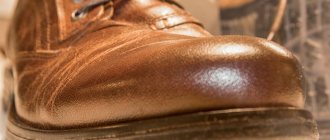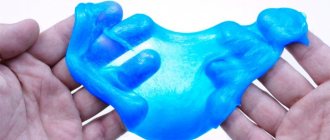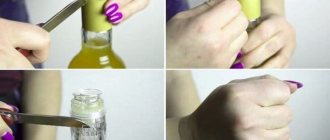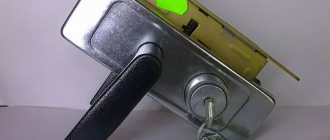Where to begin
A dispenser on a bottle of vodka or whiskey allows you to conveniently pour drinks into glasses. It is usually made of plastic. The item works like a valve: it’s easy to pour the drink out of the bottle without anything getting inside. This element protects customers from counterfeits and facilitates the process of filling glasses.
Original bottles from Jack Daniels and other designer containers can be easily adapted for homemade liqueurs, as well as used for decorative purposes. Simply remove the plastic element from the neck.
It is important to act carefully so as not to break the glass container.
How to choose
In this case, the choice of accessories depends entirely on the preferences of the bartender and the characteristics of his work. When purchasing a geyser, you should consider the following factors:
- features of the drinks in the establishment - their thickness, diameter, bottle necks;
- frequency of preparing cocktails;
- production material.
If desired, the user can decorate his workplace with beautiful bright dispensers, and neon glow-in-the-dark dispensers can also be found on sale. They look attractive and stylish. When preparing cocktails with the help of such accessories, the client will be able to enjoy a whole color show, in addition, thanks to neon signs, the bartender will be able to quickly determine the contents of the bottle in the dark and quickly find the required drink.
Why do we need alcohol bottle dispensers?
- Provide reliable protection against refilling of glass containers, such as liquor bottles.
- Promote reliable sealing due to the tightest connection with the neck.
- Allows you to achieve increased comfort during pouring due to pouring from the outlet in any radial direction.
- Helps achieve a consistent stream without air bubbles.
The introduction of bottles with dispenser caps into production allows us to reach a new level of production and helps demonstrate the high quality of closure systems. The unique closure system attracts the attention of buyers with its beautiful design using embossing or silk-screen printing.
What is the difference between a plastic cap with a dispenser and an aluminum screw cap?
Polymer closures, unlike metal screw closures, have increased strength. The latter are made of thin sheet of aluminum. If the conditions of acceptance, unloading and transportation are improper, the screw cap may be damaged and the contents of the bottle will simply leak out. Such cases have already been recorded at enterprises, and as a result, many companies suffered losses, albeit minor ones.
The most important difference is that screw closures are not equipped with a re-opening protection system, unlike modern polymer closures with a dispenser. At the same time, the cost of metal closures is higher than polymer ones. When purchasing large volumes of closures, the difference becomes obvious. In addition, polymer closures do not oxidize and do not react with an alcoholic product, which cannot be said about aluminum stoppers.
The undeniable advantage of plastic and screw closures is the ease of opening and closing. Compared to cork, no special device is required, which is very convenient and practical. Almost everyone knows how to open a screw plastic lid. It only takes a little effort.
Plastic
It is recommended to rinse the plastic to remove any remaining food or grease. If promotions accept different types of plastic, it is better to separate it by type (read how to do this here).
Plastic should also be reduced to a minimum volume: for example, bottles should be crushed. You can also remove the covers from them. If the labels on the bottles are easy to remove, then it is advisable to remove them as well. Do not fill plastic bottles with other plastic (bags, etc.).
Divide the bags and film into two types: only colorless, without drawings or paint, and everything else.
Waste paper
Waste paper can be divided into corrugated cardboard and everything else. Paper must be dry to be recycled.
It is better to fold the sorted piles as tightly as possible and, if possible, tie them with rope.
It is necessary to separate metal springs (from old calendars, notebooks), and also remove files, tape, and paper clips. A clear plastic window should be cut out of the envelopes.
Glass
It is recommended to rinse the glass and, if possible, remove the caps, dispensers and rings on the neck. It is advisable to put the broken glass in some container (for example, in the same glass jar).
Tetra Pak packaging
The packaging must be rinsed so that there is no odor or contents left behind, and then crumpled. For ease of washing and storage, the packaging can be cut.
Metal
Metal debris should be washed or rinsed to remove food and drink residues, then dried to remove moisture and, if possible, flattened. It is also advisable to remove labels from cans.
Batteries
Batteries must be carefully packaged to avoid damage during storage and transportation - at least put in a waterproof bag. Do not store batteries in metal containers. Use tightly sealed plastic boxes or special containers to store batteries.
Detailed instructions with illustrations on how to properly prepare recyclables for the campaign and how to sort waste in general can be found in a special brochure
Subscribe to our channel in Telegram!t.me/recyclemagru
Source: https://recyclemag.ru/article/ekoinstruktsiya-pravilno-gotovit-vtorsire-sdache-punkt-priema
What do manufacturers offer?
Manufacturers supply the market with all kinds of models of these miracle devices. There are liquor dispensers with additional refrigeration options, tabletop dispensers, and floor-mounted options for large water bottles.
The latter can also heat water almost to boiling point. They have a lower cooled compartment for storing food (mini-fridge).
Most often, drinking establishments order a standard tabletop jug with a tap for lemonade, which is also called a lemonade bottle, as well as a keg-shaped dispenser with a tap for dispensing beer. These are classic models, although there are also exclusive ones with non-standard designs, for example:
- Sports Cup. Three-liter container in the form of a tower-cup. This is an ideal option for sports-oriented drinking establishments, where groups of football fans often gather. This dispenser will delight guests because it has an additional capacity for ice, as well as bright lighting.
- Dispenser with submersible pump Magic Tap. A good solution for pumping drinks or water from large containers - cans, barrels or cylinders. To dispense liquid, simply press the lever. The device starts the motor from a battery or simple batteries.
- Golden Pineapple Kitchen Craft Bar Craft. The decoration of any feast is a custom dispenser in the shape of a tropical fruit. A convenient tap dispenses the pouring of drinks - cocktails, juices, cold mixes.
- Beer tower. The main body is made of wood or plastic. It serves kvass, beer, juices, fruit drinks, compotes. Some of these dispensers have neon lighting.
- Gas station. An interesting option for a gift for a man. The non-standard dispenser is suitable for both alcoholic and non-alcoholic drinks. It doesn't have a spout. The liquid is poured into the glass through a flexible hose with a dispenser button, as if a car tank is being filled with fuel.
- Fizz Saver Lemonade Maker. Convenient dispenser for carbonated drinks, which are served directly from the bottle. Simply unscrew the cap, turn the bottle over and place it on the base of the lemonade.
- Fire extinguisher dispenser. Its main part is a plastic body, as well as a dispensing hose with a tap. To make filling the container easier, a special funnel is included in the kit. With such a fire extinguisher on the table it will definitely not be boring.
- Globe. A winning gift for someone with a good sense of humor. The globe-shaped dispenser is made of food-grade high-strength plastic. It will take its rightful place in your home minibar. Equipped with a dispensing tap and sold in different sizes. For ease of pouring liquid, a funnel is attached to the globe.
Classic dispensers are usually made of glass or plastic in combination with metal parts. This is a decanter with a tap or a large transparent jar with a lid.
This attribute is intended not only for special occasions, but also for everyday use. It is convenient to serve iced tea, fruit punch, compotes, fruit drinks, juices and even drinking water.
But these liquids need to be poured into the main container of the dispenser. Another option is when the device works directly with the original container - a glass or plastic bottle, a cylinder to which it is connected.
Automatic dispensers are designed not only for cold, but also for hot drinks - cocoa, coffee, tea, hot chocolate. To maintain the desired temperature, they are equipped with a thermostat. If necessary, additional heating can be started in some models.
Is it possible to remove the dispenser from a vodka bottle?
11/21/2018 Manufacturers of closures offer improved modifications to dispensers for glass bottles. Unique models are manufactured at modern automated stations in accordance with the provisions of GOST. They are distinguished by good tightness, sufficient mechanical strength and reliability. With their help, you can create beautiful decorated caps that will attract consumers.
Types of caps with a dosing element
- Closure with a retractable spout. Used in the production of shampoo and liquid detergents.
- Cap with a special mini-lid and a hole for dosing. Used for alcohol-containing products, vodka, liqueur, rum.
- Device with feed heads. Used on various tubes or bottles. The liquid flows out by rotating the cap.
- Sprays, atomizers. They are indispensable for extracting all kinds of creams, emulsions and other liquids that have low viscosity.
Aerosol valves can also be used. All models differ in their functional features and design. More detailed information on each closure can be obtained from the manufacturers.
Comments
twist and pull up))) this is how it opens
beloved daughter
6 years 6 months
there is a button there. you need to make a few turns and it will pop out
beloved daughter
6 years 6 months
I did a million revolutions and that’s it...
maybe something is broken there... try either pressing and twisting, or vice versa, pulling and twisting... or have you already opened it?))
beloved daughter
6 years 6 months
no it doesn’t work out anyway!!!
Then marriage
And I couldn’t :-):-):-):-):-):-)
I couldn’t open it either, my husband opened it, and I still don’t know how he did it))))))
Vessels and plugs
At first, people used animal stomachs to store drinks. Later, vessels made of skins, wood, clay and metal began to be used for this purpose. The containers needed to be sealed with something. After all, tightly closed wine does not come into contact with air and improves its taste over time. Corks were made from soft types of wood. They absorbed moisture, enlarged and broke the vessels. To solve this problem, the top part of the cork was filled with resin, coated with clay and wrapped in a rag. This is how amphoras were sealed in Ancient Greece. It was convenient to transport wine in these vessels. Archaeologists still find vessels with hardened wine inside during excavations.
How to remove the dispenser: methods
The dispenser is plastic, which means it can be steamed.
How to remove a cork from a bottle, procedure:
- Pour water into a small saucepan and bring almost to a boil.
- Remove the aluminum trim from the neck.
- Place the bottle in the water upside down.
- Soak for a few minutes in hot water until the cork softens.
- Wear oven mitts to avoid getting burned! Carefully remove the dispenser from the neck.
If you can’t pull it out with your hands, use the blunt blade of a knife as a lever: pick up the edge of the dispenser and, leaning on the neck of the bottle, push it forward.
Miss Clean magazine notes that the dispenser easily returns to its place after refilling the bottle. It will fit just as tightly as before removal. Only after several procedures with boiling water can the material deteriorate.
What to do if the dispenser is installed inside the neck and it is impossible to pick it up with your fingers? And in this case there is a way to get rid of it:
- Prepare a strong metal hook.
- Fill the heating pad with hot water and wrap it around the neck of the container.
- Support the structure with a towel.
- After a few minutes, hook the dispenser and pull it out forcefully.
Some ball dispensers from imported bottles of tequila, absinthe, etc. cannot be picked up either by hand or with a hook. In this case, just use a knife: cut the element inside the neck and remove it in parts. It will not be possible to reinstall the dispenser.
Particularly confused people have adapted to pouring drinks even through a dispenser. If it is possible to remove the valve from a beautiful bottle, then it is better to do this: it will be faster and more accurate.
What is a drink dispenser
The principle of operation of the dispenser-cooler is the force of gravity, due to which the liquid leaves the container.
This is very convenient when large volumes of such drinks are needed at a feast:
- kvass;
- lemonade;
- beer;
- mineral water;
- guilt;
- melted chocolate;
- milkshake;
- milk/cream;
- freshly squeezed juice.
Externally, the dispenser looks like a jug with a tap, a barrel or a decanter. It consists of 3 main parts: the filling tower, the dispenser and the cooling compressor (in some models).
Options that are designed to serve thick hot chocolate have a heater inside and rotating blades. This allows you to maintain a uniform consistency of the contents and avoid the appearance of lumps.
Story
The Romans used oak bark to make corks. After the collapse of the empire, the lands on which this type of tree grew were captured by the Ottomans. As a result, this material was forgotten for a long time. The creator of champagne, the French monk Pierre Perignon, invented a universal cone-shaped cork.
Wine was not produced in Ancient Rus'. It was bought in other countries. In those days, any alcoholic beverage was called wine. The situation changed only after the Crimean Peninsula became part of the Russian Empire. In the 17th century, the production of glass vessels began. They could already be hermetically sealed using plugs. After the invention of the corkscrew, the shape of the plugs changed significantly. Wooden cylinders began to be pushed into the neck of the bottle.
Criterias of choice
Owners of drinking establishments most often purchase dispensers for their bars with large-volume containers that can hold a lot of beer. Also popular are the middle options, which are put on tables.
For home use, a standard 2-3 liter glass jar with a tap is suitable. And in order to surprise guests, you will need something original, for example, a Barrel dispenser in the shape of a barrel or a Bar butler, designed for 2 drinks (2 bottles) at once.
There are coolers specially made for children, depicting their favorite cartoon characters. They are installed in playrooms, entertainment centers or kindergartens. In such cases, plastic models are used that will definitely not break or fly into small fragments.
How to get it easily and quickly
So, prepare a small package and follow these instructions:
- Crumple the bag so that it looks like a thin tube and can easily slide into the neck of the bottle.
- Push the crumpled polyethylene inside the glass container, bottom first, to a depth slightly greater than the size of the cork.
- Now turn the bottle on its side and twist the bag so that the cork rolls up to the neck.
- Unfold the edges of the bag and begin to inflate it like a balloon. All this time, the cork should be near the polyethylene and not roll down.
- When the bag is inflated, it should press the stopper tightly against itself.
- Now your task is to carefully pull the bag out along with the stopper. This is not as easy to do as it seems, but it is quite possible.
- Ready! Now the cork and bottle are finally separated and both remain intact.
If for some reason you were unable to empty the bottle of its contents the first time, try again. You can even find a corresponding video on YouTube and go through in detail all the stages of extracting an item.
You may be interested: Mendeleev invented vodka - true or false? Origin and evolution of Russian vodka
No cotton
Alcohol can even be opened without popping and is very easy to do. It makes no difference what kind of cork is in the bottle: plastic or cork. First, cool the bottle well, for example, put it in an ice bucket or put it in the freezer for literally 10-20 minutes. Have a clean kitchen towel ready. Take the bottle in your hands and tilt it down a little. The neck should be directed to the side. Cover the bottle with a towel, grab the cork with your hands and turn the bottle until the cork comes out. Hold the cork when it starts to come out of the neck; there will be no pop.
Idea 13. Decorations made from plastic bottles for a summer cottage
There is a wide scope for imagination here! Experienced craftsmen create entire compositions from plastic, with palm trees and swans. But novice craftsmen should not give up the idea of transforming their site in this way. The easiest way to make flowers is from plastic bottles; you will need a sharp knife or hacksaw.
Before use, thoroughly rinse and dry the bottles. Depending on the idea, you can use material of a variety of colors. Get inspired!
You can also decorate your summer cottage with other crafts made from plastic bottles. Try making funny little frogs or funny pigs.
Is it possible to remove the dispenser from a vodka bottle?
Quite often situations arise when it becomes necessary to dismantle the dispenser from a vodka bottle. Most often this happens when it is necessary to pour another liquid there. Dispenser caps come in two modifications. Some are mounted on the top of the neck, others are installed inside the bottle. In the first case, you can lower the container into hot water, and then, hooking the dispenser with a towel, remove it. The internal dispenser plugs are almost impossible to remove. You can find a lot of information on the Internet on how to remove the dispenser from a bottle of vodka. However, all methods most often lead to damage to the closure system.
manufactures high-quality dispenser closures that are almost impossible to remove. From us you can buy dispenser caps for a bottle of vodka of appropriate quality. All products sold are repeatedly tested and checked for reliability.
Thank you for your contact to NORD PAK company!
We will definitely contact you soon!
What types of dispensers are there?
For bottles, a dispenser or geyser is used, which is placed on the neck and is designed to ensure an accurate, neat, uniform pour. In the English original it sounds like pouring spout, at the initial stage it is used in the bar business.
The entire scope of use of dispenser caps can be divided into the following sectors:
- for bottles of alcohol - the safety of the contents of branded containers is complemented by protection against counterfeiting;
- in the food industry - a number of oils are packaged in vessels with dosing attachments, which are convenient and additionally attract demand due to their originality;
- liquids, mixtures of household chemicals, oils and cosmetology lotions - ensure sanitary and hygienic standards.
The functionality lies in the uniform distribution of the fluid composition used and the elimination of the formation of bubbles.
Geysers have a special meaning for bartenders. Mixing drinks from a row of bottles takes time, it is much more convenient when all the containers are uncorked and have dispensers. Quickly preparing cocktails has purely economic benefits. Measuring utensils significantly delay the process.
The most common dispensers are made from the following materials:
- stainless steel;
- plastic;
- metal;
- tree;
- silicone;
- glass.
Household chemicals will help get rid of glue
If the remnants of the sticker are literally ingrained into the surface of the base of the product, it’s time to try aggressive means. Be careful: acetone and other solvents are not recommended for cleaning plastic, rubber, latex and some other materials. It is also unacceptable to use such aggressive agents when removing stickers from paintwork.
First, be sure to do a test: apply a little solvent to the product that needs to be cleaned of glue, in an inconspicuous place. Only after making sure that the chosen composition does not spoil the surface can you begin cleaning. How to remove glue after sticking with strong products? Try using nail polish remover, acetone, or any other household solvent.
How can you remove glue from a sticker if you don’t have any specific products at hand? Try using gels and sprays designed for cleaning your home. Compositions intended for washing glass and mirrors give good results. They usually contain alcohol, as well as substances that dissolve stubborn stains.
If you are not afraid of scratches on the surface being cleaned, you can try to remove traces of glue with a universal cleaning powder or a kitchen surface cleaner with active granules. Liquids for washing dishes and washing clothes work well with many types of adhesives. They are most effective when used after pre-soaking the remaining sticker.
Degreasers
- Scotch Remover. A cleaning agent that helps remove traces of glue from tape and labels. The main components are active citrus oils, which wash away stains from stickers, tar, ink, resinous substances and self-adhesive film.
- Liqui Moly. A universal cleaner for completely removing adhesive traces from metal, glass and plastic. Has a natural composition.
- AS TRohim. The active components penetrate deep into the dirt, soften it and partially break it down. The composition can be used to clean stubborn adhesive stains and bitumen residues. Acts gently on the surface.
- Profoam. The product can remove marker traces, oil residues, glue from labels and other contaminants. The composition is odorless.
- Fine Glass for cleaning windows. They remove traces of glue not only on glass. It can be used to clean dishes, plastic bases, electronics, household appliances, chrome and metal surfaces. The product does not leave streaks.
You can get rid of persistent adhesive traces using surface degreasing products. The most famous and accessible among them is WD-40. Wet the sticker generously with degreaser. Then start rubbing it with a sponge, moving from the center to the edges. If necessary, apply a little more product to the treated area.
Corkscrews
The first corkscrews were drills, which were used to pull stuck bullets out of weapons when they misfired. The corkscrew was invented in England by an unknown gunsmith. It was originally used to open apothecary bottles and perfume bottles. The first models had a special brush for brushing away crumbs of cork and wax.
In 1802, Edward Thomason received a patent for the manufacture of double-action corkscrews. Napoleon Bonaparte introduced a corkscrew as a mandatory item of equipment for French soldiers. In 1894, dentist William Robert Maud developed a device with a central part in the shape of a molar. This tool did not destroy the cork when opening the bottle. The new instrument began to be sold in pharmacies along with bottles of medicine.
In 1979, Herbert Allen created a Teflon-coated corkscrew that allowed the cork to be pulled out effortlessly. He also invented the lever-type corkscrew. The world's largest corkscrew weighs 350 kilograms. It was put together by Rob Higgs. The design allows you to uncork the bottle and pour wine into a glass. It took 3 years to make it.
There are currently 350 types of wine bottle openers. The corkscrew has become a collector's item. Rare specimens are sold at auctions for several thousand dollars. The largest corkscrew museum is located in the French city of Rouen. His collection numbers 15 thousand copies. Professional sommeliers use a special knife to open bottles. It was invented by Karl Weinke in 1883.
Preparatory activities
Before thinking about ways to uncork a bottle of champagne, you need to prepare this drug for manipulation. The actions include cooling, which will determine the taste of the drink.
- Sparkling wine should not be over-chilled, otherwise you will get the opposite result. Achieve a temperature of about 6-8 degrees. This is the indicator that will allow you to get delicious champagne after opening.
- The drink should not be refrigerated. For these purposes, use a bucket of crushed ice and water. First fill the cooler with cold water, then add 1/3 of the ice inside. Only after this can you lower the bottle to cool and carefully monitor the temperature.
- When cooled in a bucket, champagne reaches the desired temperature in literally 40-50 minutes. If you carry out manipulations without water only using ice, the cooling will take an indescribably long time.
- If you wish, you can cool the sparkling wine using the refrigerator by placing the bottle in the lower vegetable storage container or on the door shelf. In this case, the champagne will reach the required level in 6 hours.
- Preparatory steps include removing the foil from the neck of the bottle. To make everything look aesthetically beautiful, cut the foil with a knife under the cork, keeping a straight line. Then shoot.











